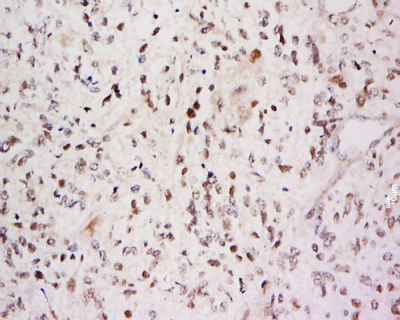SARA Polyclonal Antibody
Purified Rabbit Polyclonal Antibody (Pab)
- SPECIFICATION
- CITATIONS
- PROTOCOLS
- BACKGROUND

Application
| IHC-P, IHC-F, IF, ICC |
|---|---|
| Primary Accession | O95405 |
| Host | Rabbit |
| Clonality | Polyclonal |
| Calculated MW | 156 KDa |
| Physical State | Liquid |
| Immunogen | KLH conjugated synthetic peptide derived from human SARA |
| Epitope Specificity | 71-170/1425 |
| Isotype | IgG |
| Purity | affinity purified by Protein A |
| Buffer | 0.01M TBS (pH7.4) with 1% BSA, 0.02% Proclin300 and 50% Glycerol. |
| SUBCELLULAR LOCATION | Cytoplasm. Early endosome membrane. |
| SIMILARITY | Contains 1 FYVE-type zinc finger. |
| SUBUNIT | Interacts (via the SBD region) with SMAD2; the interaction recruits SMAD2 to the TGF-beta receptor and is disrupted by phosphorylation of SMAD2 upon TGF-beta receptor activation. Interacts with SMAD3. Interacts with TGFBR1 and TGFBR2; the interaction recruits SMAD2 to the TGF-beta receptor. Interacts with PML. {ECO:0000269|PubMed:10615055, |
| Important Note | This product as supplied is intended for research use only, not for use in human, therapeutic or diagnostic applications. |
| Background Descriptions | This gene encodes a double zinc finger motif-containing protein that participates in the transforming growth factor-beta (TGFB) signalling pathway. The encoded protein interacts directly with SMAD2 and SMAD3, and recruits SMAD2 to the TGFB receptor. There are multiple pseudogenes for this gene on chromosomes 2, 15, and X. Alternative splicing results in multiple transcript variants. [provided by RefSeq, Mar 2013] |
| Gene ID | 9372 |
|---|---|
| Other Names | Zinc finger FYVE domain-containing protein 9, Mothers against decapentaplegic homolog-interacting protein, Madh-interacting protein, Novel serine protease, NSP, Receptor activation anchor, hSARA, Smad anchor for receptor activation, ZFYVE9, MADHIP, SARA, SMADIP |
| Target/Specificity | Ubiquitous. In the brain found primarily in the cerebrovascular smooth muscle cells and reactive astrocytes. |
| Dilution | IHC-P=1:100-500,IHC-F=1:100-500,ICC=1:100-500,IF=1:100-500 |
| Format | 0.01M TBS(pH7.4), 0.09% (W/V) sodium azide and 50% Glyce |
| Storage | Store at -20 ℃ for one year. Avoid repeated freeze/thaw cycles. When reconstituted in sterile pH 7.4 0.01M PBS or diluent of antibody the antibody is stable for at least two weeks at 2-4 ℃. |
| Name | ZFYVE9 |
|---|---|
| Synonyms | MADHIP, SARA, SMADIP |
| Function | Early endosomal protein that functions to recruit SMAD2/SMAD3 to intracellular membranes and to the TGF-beta receptor. Plays a significant role in TGF-mediated signaling by regulating the subcellular location of SMAD2 and SMAD3 and modulating the transcriptional activity of the SMAD3/SMAD4 complex. Possibly associated with TGF-beta receptor internalization. |
| Cellular Location | Cytoplasm. Early endosome membrane. |
| Tissue Location | Ubiquitous. In the brain found primarily in the cerebrovascular smooth muscle cells and reactive astrocytes |

Thousands of laboratories across the world have published research that depended on the performance of antibodies from Abcepta to advance their research. Check out links to articles that cite our products in major peer-reviewed journals, organized by research category.
info@abcepta.com, and receive a free "I Love Antibodies" mug.
Provided below are standard protocols that you may find useful for product applications.
If you have used an Abcepta product and would like to share how it has performed, please click on the "Submit Review" button and provide the requested information. Our staff will examine and post your review and contact you if needed.
If you have any additional inquiries please email technical services at tech@abcepta.com.













 Foundational characteristics of cancer include proliferation, angiogenesis, migration, evasion of apoptosis, and cellular immortality. Find key markers for these cellular processes and antibodies to detect them.
Foundational characteristics of cancer include proliferation, angiogenesis, migration, evasion of apoptosis, and cellular immortality. Find key markers for these cellular processes and antibodies to detect them. The SUMOplot™ Analysis Program predicts and scores sumoylation sites in your protein. SUMOylation is a post-translational modification involved in various cellular processes, such as nuclear-cytosolic transport, transcriptional regulation, apoptosis, protein stability, response to stress, and progression through the cell cycle.
The SUMOplot™ Analysis Program predicts and scores sumoylation sites in your protein. SUMOylation is a post-translational modification involved in various cellular processes, such as nuclear-cytosolic transport, transcriptional regulation, apoptosis, protein stability, response to stress, and progression through the cell cycle. The Autophagy Receptor Motif Plotter predicts and scores autophagy receptor binding sites in your protein. Identifying proteins connected to this pathway is critical to understanding the role of autophagy in physiological as well as pathological processes such as development, differentiation, neurodegenerative diseases, stress, infection, and cancer.
The Autophagy Receptor Motif Plotter predicts and scores autophagy receptor binding sites in your protein. Identifying proteins connected to this pathway is critical to understanding the role of autophagy in physiological as well as pathological processes such as development, differentiation, neurodegenerative diseases, stress, infection, and cancer.


